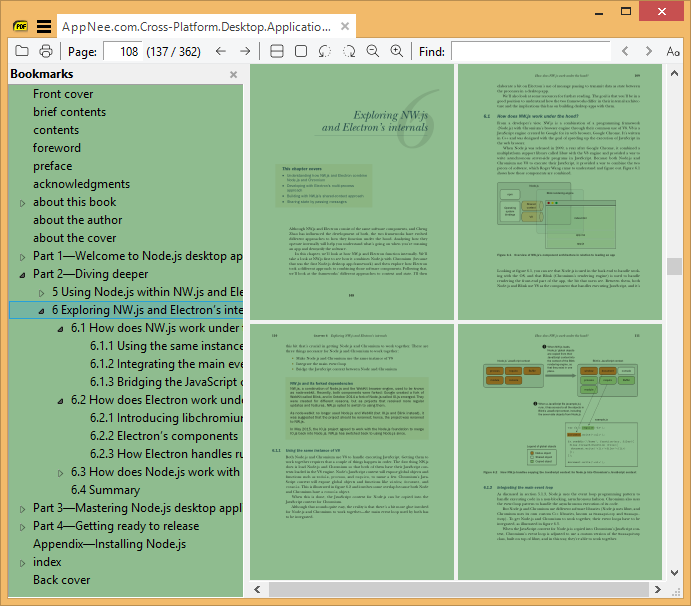| Ⅰ | This article along with all titles and tags are the original content of AppNee. All rights reserved. To repost or reproduce, you must add an explicit footnote along with the URL to this article! |
| Ⅱ | Any manual or automated whole-website collecting/crawling behaviors are strictly prohibited. |
| Ⅲ | Any resources shared on AppNee are limited to personal study and research only, any form of commercial behaviors are strictly prohibited. Otherwise, you may receive a variety of copyright complaints and have to deal with them by yourself. |
| Ⅳ | Before using (especially downloading) any resources shared by AppNee, please first go to read our F.A.Q. page more or less. Otherwise, please bear all the consequences by yourself. |
| This work is licensed under a Creative Commons Attribution-NonCommercial-ShareAlike 4.0 International License. |

JavaScript used to be just a scripting language running in the browser’s sandbox environment. Since the release of Node.js in 2009, JavaScript has show extraordinary talents on the server side, the Internet of Things, mobile native application development, and even desktop application development. In the past, to develop desktop applications, we need to learn the exclusive programming languages and development frameworks for different platforms, which not only costs a lot, but also takes a lot of time to make a desktop application that supports and is compatible with multiple OS platforms, and basically needs to be implemented by different teams for different platforms.
JavaScript makes it all so much easier these days that a Web developer can easily create a desktop application that works with all three popular operating systems. This only does significantly reduce the learning curve for developers, but also increases the development productivity exponentially. This is all thanks to NW.js and Electron, two of the most popular frameworks for developing desktop applications using the Web technologies. They combine Chromium and Node.js very well: Chromium enables Web development techniques to be used in desktop applications, while Node.js provides the ability to access the operating system APIs. The combination of the two makes it possible to develop desktop applications using JavaScript.
With Electron and NW.js, you can apply existing Web development techniques to desktop applications that can be developed using only HTML, CSS, and JavaScript. In addition, the application developed can work on Windows, Mac and Linux platforms, greatly reducing development costs and time. At present, NW.js and Electron have been widely used by major companies all over the world, many popular cross-platform desktop applications were developed with them, and more and more desktop applications are being developed using them.
Cross-Platform Desktop Applications: Using Electron and NW.js is a step-by-step guide to desktop application development using Electron and NW.js, two of the most popular software frameworks available today, suitable for developers who know HTML, CSS, and JavaScript. The book is divided into 4 parts, systematically explains the whole process of developing desktop applications very clearly and in place. And this book contains a large number of coding examples, and each example is a fully equipped, practical application. Even better, the author explains and clarifies the key code in the examples in great detail, so that the reader can feel the experience of developing desktop applications using these two frameworks through actual coding.

// Table Of Contents //
- Part 1. Welcome to Node.js desktop application development
- Chapter 1. Introducing Electron and NW.js
- Chapter 2. Laying the foundation for your first desktop application
- Chapter 3. Building your first desktop application
- Chapter 4. Shipping your first desktop application
- Part 2. Diving deeper
- Chapter 5. Using Node.js within NW.js and Electron
- Chapter 6. Exploring NW.js and Electron’s internals
- Part 3. Mastering Node.js desktop application development
- Chapter 7. Controlling how your desktop app is displayed
- Chapter 8. Creating tray applications
- Chapter 9. Creating application and context menus
- Chapter 10. Dragging and dropping files and crafting the UI
- Chapter 11. Using a webcam in your application
- Chapter 12. Storing app data
- Chapter 13. Copying and pasting contents from the clipboard
- Chapter 14. Binding on keyboard shortcuts
- Chapter 15. Making desktop notifications
- Part 4. Getting ready to release
- Chapter 16. Testing desktop apps
- Chapter 17. Improving app performance with debugging
- Chapter 18. Packaging the application for the wider world
- Appendix. Installing Node.js
// System Requirements //
- Node.js (v4.0+)
- NW.js (0.14+)
- Electron (0.37+)
// Book Example Codes //
// Download URLs //
| Format | Download | Size |
 |
15.6 MB |
(Homepage)
| If some download link is missing, and you do need it, just please send an email (along with post link and missing link) to remind us to reupload the missing file for you. And, give us some time to respond. | |
| If there is a password for an archive, it should be "appnee.com". | |
| Most of the reserved downloads (including the 32-bit version) can be requested to reupload via email. |